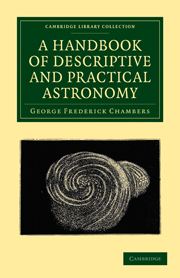Book contents
- Frontmatter
- PREFACE
- SUPPLEMENT
- Contents
- LIST OF ILLUSTRATIONS
- PRINCIPAL AUTHORITIES
- Errata
- A Handbook of Descriptive and Practical Astronomy
- BOOK I A SKETCH OF THE SOLAR SYSTEM
- CHAPTER I THE SUN
- CHAPTER II THE PLANETS
- CHAPTER III VULCAN
- CHAPTER IV MERCURY
- CHAPTER V VENUS
- CHAPTER VI THE EARTH
- CHAPTER VII THE MOON
- CHAPTER VIII MARS
- CHAPTER IX THE MINOR PLANETS
- CHAPTER X JUPITER
- CHAPTER XI SATURN
- CHAPTER XII URANUS
- CHAPTER XIII NEPTUNE
- BOOK II ECLIPSES AND THEIR ASSOCIATED PHENOMENA
- BOOK X METEORIC ASTRONOMY
- APPENDICES
- INDEX TO SUBJECTS
- INDEX TO NAMES
- Plate section
CHAPTER V - VENUS
Published online by Cambridge University Press: 05 July 2011
- Frontmatter
- PREFACE
- SUPPLEMENT
- Contents
- LIST OF ILLUSTRATIONS
- PRINCIPAL AUTHORITIES
- Errata
- A Handbook of Descriptive and Practical Astronomy
- BOOK I A SKETCH OF THE SOLAR SYSTEM
- CHAPTER I THE SUN
- CHAPTER II THE PLANETS
- CHAPTER III VULCAN
- CHAPTER IV MERCURY
- CHAPTER V VENUS
- CHAPTER VI THE EARTH
- CHAPTER VII THE MOON
- CHAPTER VIII MARS
- CHAPTER IX THE MINOR PLANETS
- CHAPTER X JUPITER
- CHAPTER XI SATURN
- CHAPTER XII URANUS
- CHAPTER XIII NEPTUNE
- BOOK II ECLIPSES AND THEIR ASSOCIATED PHENOMENA
- BOOK X METEORIC ASTRONOMY
- APPENDICES
- INDEX TO SUBJECTS
- INDEX TO NAMES
- Plate section
Summary
Venus, when in a favourable position, is to us the most conspicuous member of the planetary system. Its apparent diameter differs considerably at different times: this is owing to the greater extent of variation of distance than occurs in the case of Mercury. Its phases are similar to those of Mercury, to which the reader is referred. The discovery of the phases of Venus is due to Galileo, who announced the fact to his friend Kepler in the following logograph or anagram: –
“Hæc immatura, a me, jam frustra, leguntur.—oy.”
These things not ripe, as yet concealed from others, are read by me.
Which, when transposed, becomes —
“ Cynthiæ figuras, aemulatur mater Aniorum.”
Venus imitates the phases of Cynthia [the Moon].
Little is known of the appearance of this planet's surface, owing to its dazzling brilliancy when viewed in a telescope; notwithstanding this, however, spots are occasionally visible. These spots are not supposed to be connected with the planet's surface, but rather to belong to its atmosphere. Schröter has suspected the existence of numerous high mountains on its surface. The rotation of Venus on its axis was discovered by D. Cassini in the year 1667.
- Type
- Chapter
- Information
- A Handbook of Descriptive and Practical Astronomy , pp. 34 - 36Publisher: Cambridge University PressPrint publication year: 2010First published in: 1861



